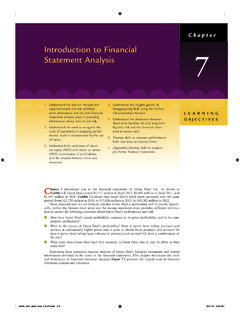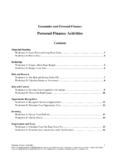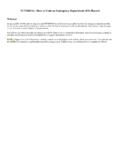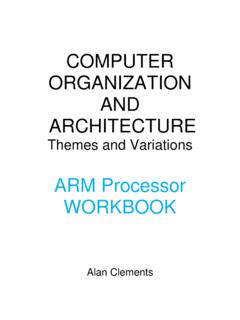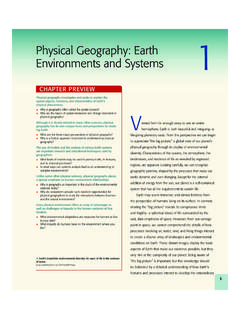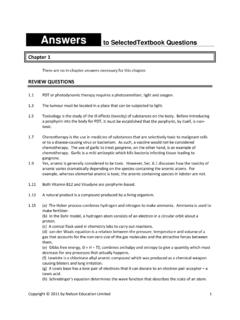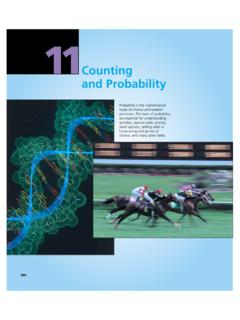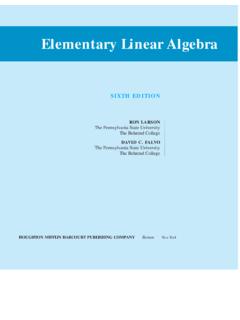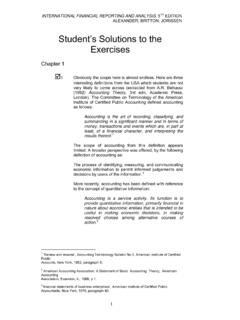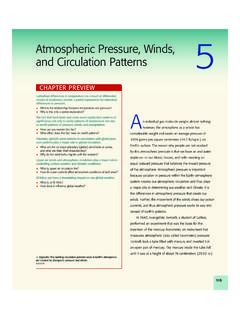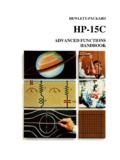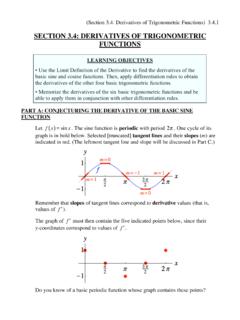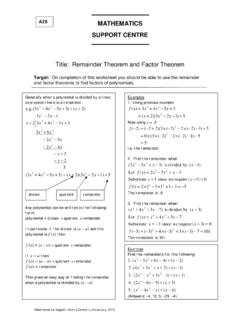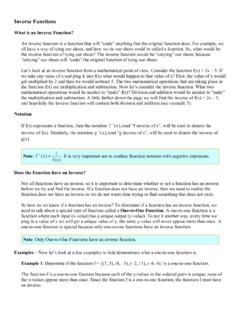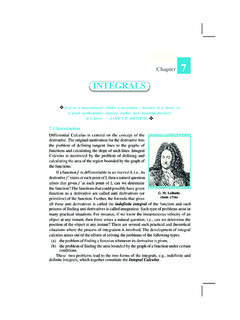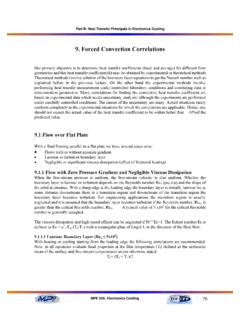Transcription of 11 Limits and an Introduction to Calculus - Cengage
1 749 Limits and an Introductionto Introduction to Techniques for Evaluating The Tangent Line Limits at Infinity and Limits of The Area Problem110100,00006 Section , Example 3 Average 11 Limits and an Introduction to CalculusThe Limit ConceptThe notion of a limit is a fundamentalconcept of Calculus . In this chapter, you will learnhow to evaluate Limits and how they are used in the two basic problems of Calculus : thetangent line problem and the area 1 Finding a Rectangle of Maximum AreaYou are given 24 inches of wire and are asked to form a rectangle whose area is as largeas possible.
2 What dimensions should the rectangle have?SolutionLet represent the width of the rectangle and let represent the length of the is follows that as shown in Figure So, the area of the rectangle isFormula for areaSubstitute for this model for area, you can experiment with different values of to see how toobtain the maximum area. After trying several values, it appears that the maximum areaoccurs when as shown in the limit terminology, you can say that the limit of Aas wapproaches 6 is 36.
3 This iswritten asNow try Exercise 6A limw 6 12w w2 , , 6wl = 12 ww 12w w 12 w wA lwl 12 w2w 2l to LimitsWhat you should learn Understand the limit concept. Use the definition of a limit toestimate Limits . Determine whether Limits offunctions exist. Use properties of Limits anddirect substitution to you should learn itThe concept of a limit is useful inapplications involving instance, in Exercise 5 on page757, the concept of a limit is used toverify the maximum volume of anopen 2010/used under license from Introduction to Limits751 Definition of LimitExample 2 Estimating a Limit NumericallyUse a table to estimate the limit Then construct a table that shows values of for two sets of values one set that approaches 2 from the left and one that approaches 2 from the table, it appears that the closer gets to 2, the closer gets to 4.
4 So, youcan estimate the limit to be 4. Figure adds further support to this try Exercise Figure , note that the graph ofis continuous. For graphs that are not continuous, finding a limit can be more 3 Estimating a Limit NumericallyUse a table to estimate the limit Then construct a table that shows values of for twosets of -values one set that approaches 0 from the left and one that approaches 0 fromthe the table, it appears that the limit is 2. This limit is reinforced by the graph of (see Figure ).Now try Exercise x f x x x 1 1.
5 Limx 0 x x 1 1f x 3x 2f x xx-f x f x 3x 2 3x 2 Definition of LimitIf becomes arbitrarily close to a unique number as approaches from either side, then the limitof as approaches is This is written aslimx c f x x cxLf x x x 1 212345 1 212345(2, 4) f(x) = 3x 2x yFigure y 1 21234 11345x 0 (0, 2) f is undefined at x = 0. xx + 1 1f(x) =lim f(x) = 2 Figure 11 Limits and an Introduction to CalculusIn Example 3, note that has a limit as even though the function is notdefined at This often happens, and it is important to realize that the existence ornonexistence of at has no bearing on the existence of the limit of as approaches Example 5 Using a Graph to Find a LimitFind the limit of as approaches 3, where is defined asSolutionBecause for all other than and because the value of is immaterial.
6 It follows that the limit is 2 (see Figure ). So, you can writeThe fact that has no bearing on the existence or value of the limit as approaches 3. For instance, if the function were defined asthen the limit as approaches 3 would be the try Exercise x 2, 4, x 3x 3xf 3 0limx 3f x 3 x 3xf x 2f x 2,0, x 3x x x x cf x x 0f x Example 4 Using a Graphing Utility to Estimate a LimitEstimate the 1 x3 x2 x 1x 1 Numerical SolutionLet Figure Figure , it appears that the closer gets to 1,the closer gets to 2.
7 So, you can estimate the limitto be try Exercise x xCreate a table that shows valuesof f(x) for several x-values near x x3 x2 x 1 x 1 .Graphical SolutionUse a graphing utility to graphusing a decimalsetting, as shown in Figure Figure , you can estimate the limit to be 2. As you use thetracefeature, notice that there is no value given for when and that there is a hole or break in the graph at x 1,y the trace feature todetermine that as x getscloser and closer to 1, f(x)gets closer and closer to 2from the left and fromthe x x3 x2 x 1 x 1 3f(x) =2, x 30, x = 3x y 1124 1134 Figure students may come to think that alimit is a quantity that can be approachedbut cannot actually be reached, as shown inExample 4.
8 Remind them that some limitsare like that, but, as Example 2 shows, manyare Introduction to Limits753 Limits That Fail to ExistIn the next three examples, you will examine some Limits that fail to 6 Comparing Left and Right BehaviorShow that the limit does not the graph of the function given by In Figure , you can see that for positive valuesand for negative -valuesThis means that no matter how close gets to 0, there will be both positive and negative values that yieldandThis implies that the limit does not try Exercise 7 Unbounded BehaviorDiscuss the existence of the In Figure , note that as approaches 0 from either the right or theleft,increases without bound.
9 This means that by choosing close enough to 0, youcan force to be as large as you want. For instance,will be larger than 100 whenyou choose that is within of 0. That is,Similarly, you can force to be larger than 1,000,000, as is not approaching a unique real number as approaches 0, you can conclude that the limit does not try Exercise x f x 1x2>1,000,0000< x <11000f x f x 1x2> < x <110110xf x f x xf x xf x 1 0 1x2f x x 1x-xx<0. x x 1,xx>0 x x 1,x-f x x 0 x xWhat s Wrong?You use a graphing utility tograph using a decimalsetting, asshown in the figure.
10 You use thetracefeature to conclude thatthe limitdoes not exist. What s wrong? 1 x3 1x 1y1 x3 1x 1x y 1 2 3123 1123f(x) =1x2 Figure 1 212 212x yf(x) = f(x) = 1f(x) = 1 x xFigure reinforcing the nonexistence of thelimits in Examples 6 and 7 by constructingand examining a table of values. Encouragestudents to investigate Limits using a varietyof 8 Oscillating BehaviorDiscuss the existence of the In Figure , you can see that as approaches 0,oscillatesbetween and 1. Figure , the limit does not exist because no matter how close you are to 0, it is possible tochoose values of and such that andas indicated in the try Exercise 6, 7, and 8 show three of the most common types of behavior associatedwith the nonexistenceof a 1x2 1sin 1x1 1x2x11 11 11xf(x) = sinx y 1f x xf x sin 1 x.
